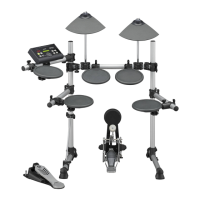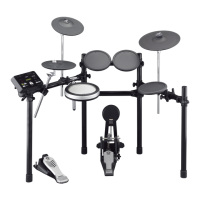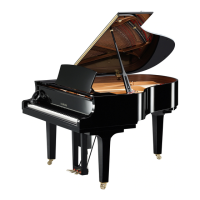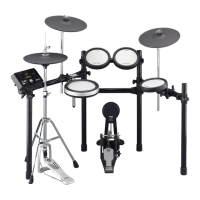Do you have a question about the Yamaha DME32 and is the answer not in the manual?
Main title and identification for the digital mixing engine.
Critical safety warnings regarding product usage to prevent fire or electrical shock.
Guidelines for safe operation, ventilation, and environmental conditions.
Information on potential interference with other electronic equipment.
Lists the items included in the DME32 package.
Lists registered trademarks related to the product and its software.
Provides an overview of the DME32's architecture and functionality.
Details the key sonic, memory, I/O, control, and remote capabilities of the DME32.
Highlights the capabilities of the DME Manager software for system design.
Outlines the initial procedure to get the DME32 system operational.
Describes serial and USB connections between the DME32 and a computer.
Instructions for connecting the power supply to the DME32 unit.
Step-by-step guide for installing the DME Manager software on a PC.
Procedure for installing the necessary driver for USB connectivity.
Detailed explanation of the DME32's front panel controls and indicators.
Description of the DME32's rear panel connectors and switches.
Explains the different operating modes: Edit, Cable, and Run.
Details the primary DME Manager window and its status bar information.
Overview of the DME Manager's tool bar and various menu functions.
Explains DME Manager components and how to build configurations.
Describes how to interact with component control windows and their elements.
Outlines the procedural steps for creating and modifying system configurations.
Instructions for connecting and disconnecting components within a configuration.
Procedures for saving, saving-as, and closing system configurations.
Steps for compiling configurations and sending them to the DME32.
How to switch DME Manager to Run mode for real-time system control.
Procedure for adjusting component parameters via DME Manager or front panel.
Methods for saving and recalling system snapshots (scenes).
Steps to load previously saved system configurations.
How to edit and preview scenes without a connected DME32.
Procedure for linking multiple parameters for simultaneous control.
Guide to adjusting component appearance, size, and title.
How to set up and manage passwords for system access control.
Method for assigning direct parameter access to the front panel button.
Instructions for printing system configuration details.
Details on the Automatic Mixer components and their parameters.
Explanation of Cascade components for signal sharing in multi-unit systems.
Information on Crossover components, filter types, and slopes.
Description of Delay components and their time/level controls.
Overview of Dynamics components like Compander, Compressor, and Gate.
Details on various effect components like Reverb, Delay, and Modulation.
Explanation of Parametric EQ (PEQ) and Graphic EQ (GEQ) components.
Description of Fader components for channel level control.
Details on High-Pass (HPF), Low-Pass (LPF), Band-Pass (BPF) filters.
Information on Matrix Mixer components for signal routing.
Overview of Pan components including LCR, Surround, and Stereo panning.
How to recall configurations and scenes using the front panel controls.
Steps to edit component parameters directly on the DME32's front panel.
Methods to restrict access using Scene Recall Only or Full Protect modes.
How to set the wordclock source using the front panel.
Overview of the General Purpose Interface for remote control.
Details on GPI connectors, pinouts, and wiring.
Configuration of GPI inputs for scenes, parameters, and emergency.
Functionality of the Emergency mode triggered by a GPI input.
Information on using PCMCIA memory cards for configuration storage.
Instructions for safely handling PC Cards in the DME32.
Steps required to format PC Cards before use with the DME32.
Procedures for saving to and loading from PC Cards.
Explains the importance of wordclock for digital audio synchronization.
How to choose between internal and external wordclock sources.
Guidelines for correctly terminating wordclock signals via BNC cables.
Overview of cascading DME32 units and system considerations.
Details on using SCSI cables for connecting multiple DME32 units.
Illustrative examples of cascading DME32s with I/O cards.
Configuration of MIDI channels, ports, and message handling.
Mapping scenes and configurations to MIDI Program Change messages.
Mapping component parameters to MIDI Control Change messages.
Procedures for saving and loading MIDI configuration settings.
Overview of optional mini YGDAI cards and their specifications.
Guidance on selecting and physically installing I/O cards.
Information on using external AD824 and DA824 converters.
Common symptoms and solutions for DME32 operational issues.
Common symptoms and solutions for DME Manager software issues.
Mapping of component names across different views in the software.
List of DME32 error messages and their corresponding solutions.
Technical specifications for sampling frequency, memory, display, and power.
Details on control interfaces, formats, and connector pinouts.
Table for assigning scenes/configurations to MIDI Program Changes.
Table for assigning parameters to MIDI Control Changes.
Explanation of MIDI message formats for Program Change and Control Change.
Definitions of important technical terms used in the manual.
| Type | Digital Mixing Engine |
|---|---|
| A/D Resolution | 24-bit |
| D/A Conversion | 24-bit |
| Network | Ethernet |
| Software | DME Designer |
| Control Software | DME Designer |
| Internal Processing | 32-bit |
| Digital Inputs | AES/EBU |
| Digital Outputs | AES/EBU |
| Analog Inputs | 8 |
| Analog Outputs | 8 |
| Control Interface | RS-232 |
| Compatibility | Windows |
| Dynamic Range | 110dB |
| Frequency Response | 20 Hz - 20 kHz |
| Power Supply | AC100V-240V, 50/60Hz |
| Processing | DSP |












